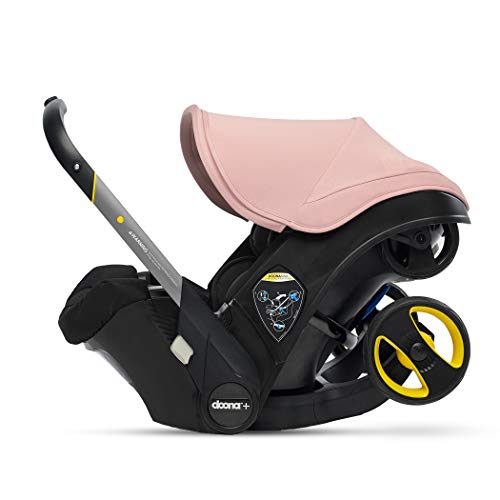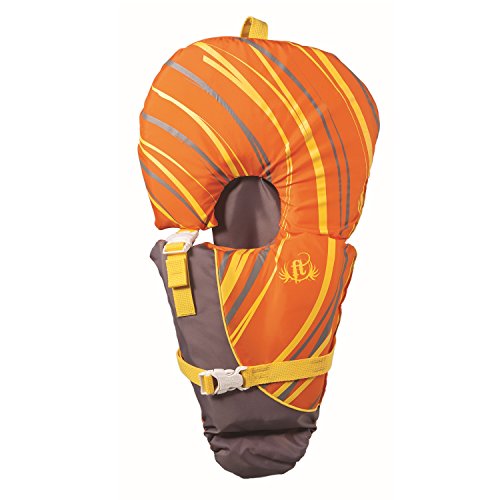Taking a cab ride is something most parents will encounter at some point in their time after having a baby. Even if you have a car, there are plenty of reasons you might end up taking one.
A vacation to a different city or a night out to eat in your own city could all be opportunities to practice good etiquette when loading up into the backseat of a taxi with your family.
When my family still consisted of three children, one of whom was an infant at the time. We found ourselves in a tricky situation when our car needed significant repairs. While we had our car fixed, we needed to take cab rides for our grocery store trips.
After calling a few different taxi companies in our area we found one that seemed the most suitable for our situation, they offered vans in their services which is great for families!
You know your family dynamic best, and you’ll be the only one who can make the important parenting decisions that riding in a taxi with a baby brings up.
Being prepared, informed, and knowledgeable will make a big impact on safety. Below are the top tips parents need to know when traveling with an infant abroad.
How To Travel With A Baby In A Taxi
We all know that having our infant along for a ride in our own vehicle requires that they’re safely secured at all times. A 5-point-harness safety seat is a parent’s reassurance, if a wreck ever happened, your baby would remain as safe as possible.
Are the requirements the same as a privately owned vehicle?
In the US, it’s completely legal to hop in a taxi with your baby without their usual car seat. The rule of thumb goes as follows: when a driver chooses to drive a vehicle that offers a for-hire practice, the same laws don’t apply to that vehicle.
Passenger-based vehicles driving for personal use have completely different requirements with insurance, rules, and laws when out driving.
In turn, the passenger is the one hiring the vehicle, and since the taxi isn’t readily equipped with a car seat, there’s not one required if pulled over.
For safety reasons, small babies should have a restraint system
If you’ve taken taxi rides before, you’ll know that they’re driven by complete strangers. They’re everyday people who drive a taxi to make money.
Some of these people are great drivers and truly strive to make you feel safe in their taxi. However, that isn’t always the case. I’ve been on plenty of taxi rides I was eager to wrap up because they were driving erratically.
If you have an infant or child under the age of 2 years old riding with you, it’s best to bring along an infant car seat or at least a booster seat for babies who can sit upright.
View in gallery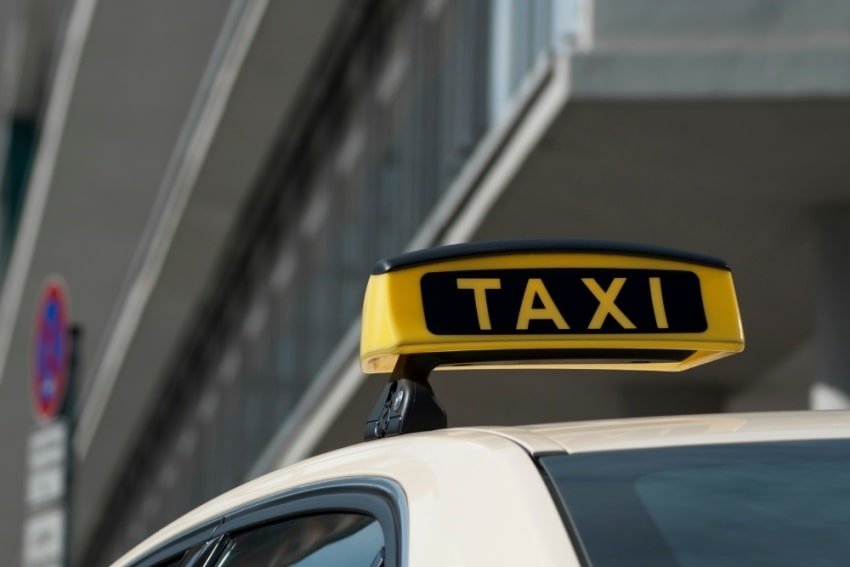
It’s your job to ensure the safety of your child during a taxi ride, so make sure you’ve thought over the size and abilities your child specifically has.
Are Uber, Lyft, and Rideshare’s rules any different than a taxi?
Uber and Lyft fall under the same category as Taxi Services legally, but parents might want to consider the atmosphere of riding in these as opposed to the classic yellow taxi.
It’ll feel more like a personal vehicle to you, thus causing more desire to have a car seat on hand. While Rideshare is someone’s vehicle that you simply make an agreement to tag along the trip for.
There are a few things to consider while riding in each of these vehicles.
Uber and Lyft
These companies are similar to taxi services. They don’t withhold any responsibility for their customers with young children. Although, how you’ll feel while being inside of an Uber or Lyft will be quite different than the atmosphere of a taxi.
And you might wish to bring a safety seat for your baby. Uber or Rideshare vehicles are personally owned and operated vehicles, meaning the driver takes personal care of all maintenance of the vehicle, etc.
Plus, you don’t know how well these drivers care for their vehicles since the owners are solely responsible for their vehicles.
The tire could blow out. Engine troubles could happen on the highway or other incidents that cause a reason for safety concerns. Bringing a car seat for these trips is the best practice overall.
Rideshare
Rideshare, on the other hand, still falls under the category of personal-use vehicles. You must always equip your baby with a car seat if you’re opting for rideshare. These vehicles are not looked out for in any way, by a company.
You and the driver of the vehicle maintain complete responsibility for any and all small children during a ride. If pulled over while accompanying a rideshare driver, you’ll likely be ticketed for not buckling up your infant.
Should You Have Your Baby Sit On Your Lap In A Taxi
One of the worst options you can choose as a parent is to prop your child up on your lap during a cab ride. A safety belt is meant to restrain a body in a car in the event of a crash.
If anything, you should opt to have your little one in their own seatbelt and someone older off to the side without a seatbelt, if necessary.
The problem with having your child sit on your lap is that there’s no way for you to hold your child in place during a significant car wreck.
View in gallery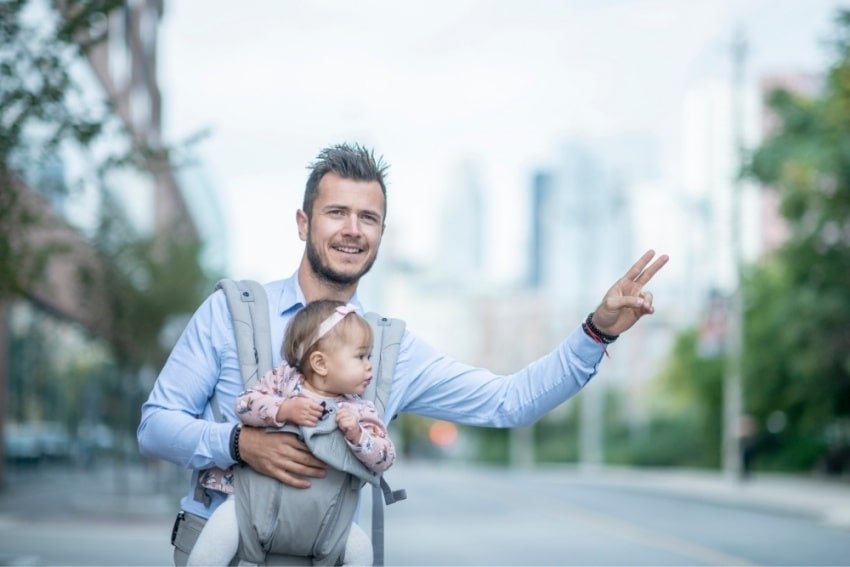
The impact would be too strong for you to maintain them in your lap through the force. As humans, we simply aren’t that strong.
Don’t sit any child of any size or age on your lap. Oftentimes cab drivers don’t keep up on child safety laws. It’s up to you to say no if a driver suggests this to you.
How To Properly Use A Seatbelt On A Small Child
If you find that you have no car seat and are taking a taxi ride with a small child, follow these steps to strap them in a seatbelt in the most effective way:
Place only one child per seatbelt
- Pull the seat belt as snug as possible
- Ensure the lap belt is resting snugly right on top of the thighs or close as you can
- If your child wants to put the shoulder strap behind the back or under the armpit adjust it in the proper position. Improperly worn shoulder straps cause far more damage to the stomach, back, and spinal cords. Shoulder straps by the neck aren’t a significant cause of damage during a wreck.
Is It Okay For Two people To Share One Seatbelt
It’s best practice to have each child in their own seatbelt, it’s less safe for each person to share a seatbelt.
During a crash weight amplifies due to the G-Forces in action. If there are two bodies in a lap belt, one of the bodies will end up crushing the other due to the extreme weight.
For instance, in a wreck going 30mph – with 20-25 G’s – a 100lbs will feel like 2,500lbs. This is especially dangerous for a child to sit on an adult’s lap since the adult is so much heavier than the child.
Are There Better Options Than Riding Carseat Free In A Cab
Yes, of course, there are better options than traveling in a taxi without a car seat. And it makes sense, for us parents to still feel uneasy about throwing our child into a taxi with a driver we don’t know – to hold our breath the entire ride.
If this is you, then rest assured there are better options available when riding in a taxi with your baby. There are reasonable concerns that people have when entering a vehicle with unknown drivers.
No passenger will know their driver’s history on the roads, their style of driving, or what kind of day they are having.
Taxi drivers can be impatient, but it’s their job to wait for passengers to be comfortable and safely secured. Here are a few ways to be as safe as possible during a cab ride.
View in gallery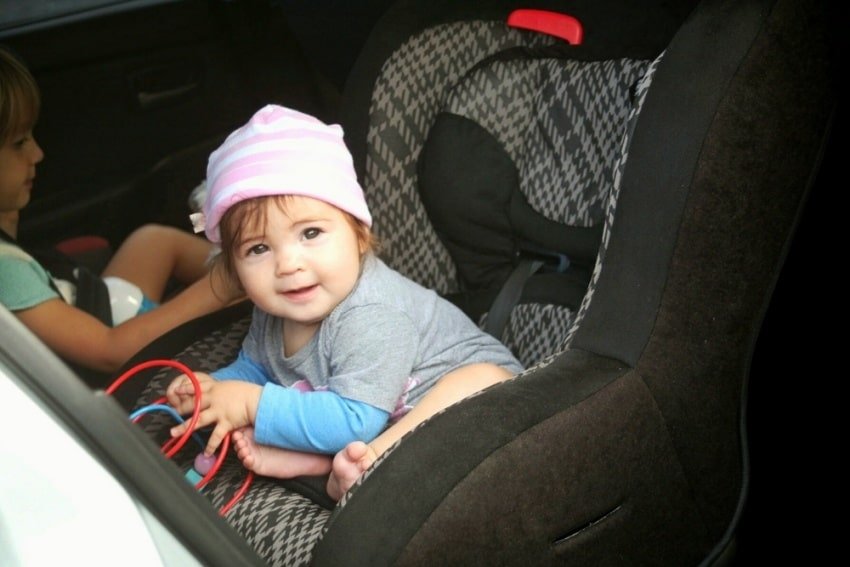
You Can Invest In A Car Seat Or Booster Seat Alternatives
Traveling by a bulky car seat or booster seat is oftentimes impractical, especially if you have several small children. This can be an even worse nightmare if you’re going on a family vacation where you know you’ll be out on the town or around site seeing.
Carseats and booster seats are pretty heavy to maneuver around, but thankfully you aren’t the first parent to encounter this dilemma. There are specific companies that create travel-friendly baby products for the rides.
If know that you’ll be riding in a taxi with your infant often enough, there are car seat-strollers specifically designed for a taxi. Invest in one, if you know you’ll put it to use often enough! They can be a life-saver for those who take a taxi a few times a week.
These products make it ideal for parents who use alternative forms of transportation like taxis, cabs, or shuttles which often don’t have car seats available for parents to use.
Doona All-in-One Travel System
If you live in a big city where you frequently take a taxi, bus, or cab rides, this is a great alternative for you to have a fully equipped infant seat that’s heavy or bulkier.
You might have a hard time carrying around a car seat and stroller together on a taxi ride – with the Doona its all-in-one!
Collapse the stroller and infant seat down to just the infant seat when you enter the taxi, strap it in as you would a regular car seat. Once you arrive at your destination, swiftly transform it back into a stroller for the walk ahead.
With the option of 6 unique colors in the car seat world, you’ll find this style of infant product to be fun for outings.
One thing that’s nice about having such a lightweight seat-stroller is that you can get it down on the beach, walk around gift shops, and maneuver in small places with it easily.
It doesn’t come with an undercarriage for extra items, but you can hang a diaper bag on the handle easily, making this a sleek look for modern parenting.
Constructed from a lightweight aluminum frame, it’s a base seat for your personal car. The foldable seat protector does not damage anyone’s seats.
Pros
- The Doona has Anit-Rebound Protection
- Parents use this travel seat for well over a year old
- Truly offers convenience to parents on the go
- Converting it is easy
- Your baby doesn’t wake up from the sidewalk to seat transfers
Cons
- It’s more confined than other strollers and seats
[amalinkspro type=”cta-btn-css” ctabtn-id=”” asin=”” apilink=”https://www.amazon.com/dp/B07HMBNCKJ?tag=mominformedcom-20&linkCode=osi&th=1&psc=1″ addtocart=”false” new-window=”true” nofollow=”true” alignment=”aligncenter”]Buy on Amazon[/amalinkspro]
Gen 5 Ride Safer Travel Vest
The Ride Safer is a low-cost, travel-friendly, 5-point-harness system that turns a regular seatbelt into a toddler safety belt.
This is built for children who are 30lbs or aged 3 years and older. It turns your cab ride from a nervous wreck, into a conveniently relaxed drive to your destination.
One truly great aspect is how compact it is, weighing in at just 2.5lbs. It can fit snugly in the diaper bag, so you’ll be hands-free before your ride.
Fully equipped with metal buckles, a removable headrest, and a safety system that exceeds all of the Federal Motor Vehicle Safety Standards requirements.
A practical safety choice for your little one regardless of how little or often you plan to use cab services. While you’re waiting for your taxi, your child can put it on beforehand to save time as well.
It wears like a vest. It can be attached to the seat belt like a vest or you can add the last strap between the legs for a full 5-point-harness system.
Pros
- You can use it easily for rideshares and other personal uses
- It makes traveling easy
- A small backpack is included for storage
- Learning to use it is fuss-free
- Doesn’t have too many unnecessary straps in the set-up
Cons
- It can be uncomfortable for kids at times
[amalinkspro type=”cta-btn-css” ctabtn-id=”” asin=”” apilink=”https://www.amazon.com/dp/B07WMTQHCL?tag=mominformedcom-20&linkCode=osi&th=1&psc=1″ addtocart=”false” new-window=”true” nofollow=”true” alignment=”aligncenter”]Buy on Amazon[/amalinkspro]
Do You Need A Carseat To Take A Taxi In New York City
Locals and visitors to New York City, who are also parents to babies and toddlers, will likely wonder whether it’s lawfully okay to ride in the busy city’s various taxi services without a car seat.
While it happens more often on the roads for kids to ride with no safety seat regardless of the law, it’s best practice to always have a car seat for small children.
View in gallery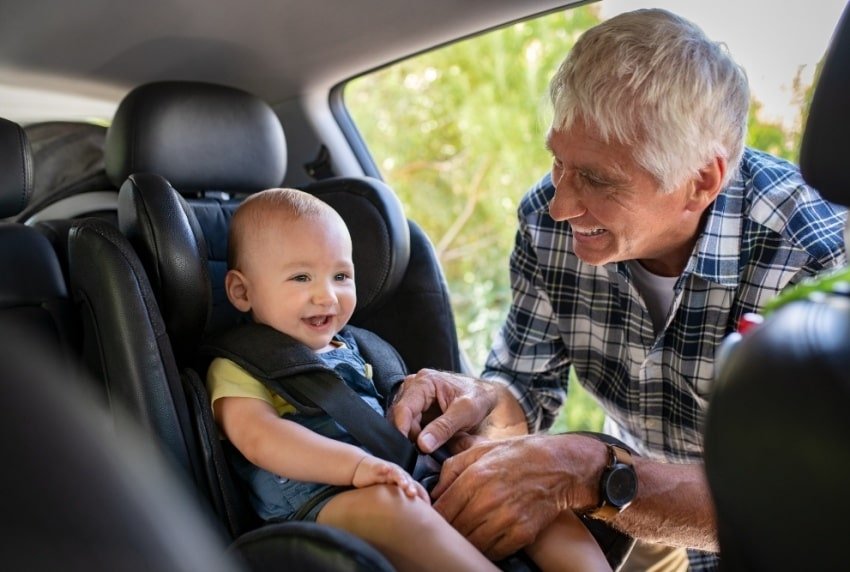
Is it illegal to ride without a car seat in New York City?
It isn’t technically illegal to ride without a car seat. In a big city where drivers can be erratic and traffic is always on the move, it’s up to parents to ensure their family arrives safely.
A day of sightseeing would be a lot more difficult lugging around a car seat, so what do families do when they visit or live in the area?
Can I bring my own infant seat for cab rides?
If you’ve brought your own car seat to take in a cab, the taxi driver is required to let you install it, regardless of the extra time, it takes.
They can get impatient, but keep your body out of the car until it’s fully installed so they don’t pull off before you’re finished!
Parents should consider using a local ‘traveling families’ cab service
In a big city, it’s best practice to use a car seat when possible. But, according to nyc.gov, it’s not illegal for children under the age of 7 to sit on their parent’s lap.
Each borough in New York has companies that offer car seat equipped cab services to travel parents specifically. If you want to see a list of these companies, you can visit mommypoppins.com.
These companies are specifically prepared to assist parents of young children with their transportation needs.
You can request infant car seats or even toddler seats for your ride. It’s a great option because they understand that parents need more time in their endeavors.
How To Take a Baby on Public Transportation: Bus, Greyhound Bus, Shuttle Bus
When traveling by Greyhound, it’s very important to equip your trip with proper seating for each child in your family.
Not only are these trips generally longer, since they are designed for city-to-city and state-to-state traveling, but there’s also more of a chance your baby will have more needs while onboard a Greyhound bus.
Greyhounds Requirements for Traveling Parents
They require that all children be safely secured in the proper seat belts for all trips. The seating is fully equipped with lap belts and shoulder straps for you to maneuver properly in your child’s own car seat.
Infant and booster seats do fit properly, but you can check in with your state laws to find out the exact age that older children can ride without a booster seat.
If you have a child under the age of 2-years-old, you are welcome to have them sit on your lap. They also ride for free on Greyhound busses.
View in gallery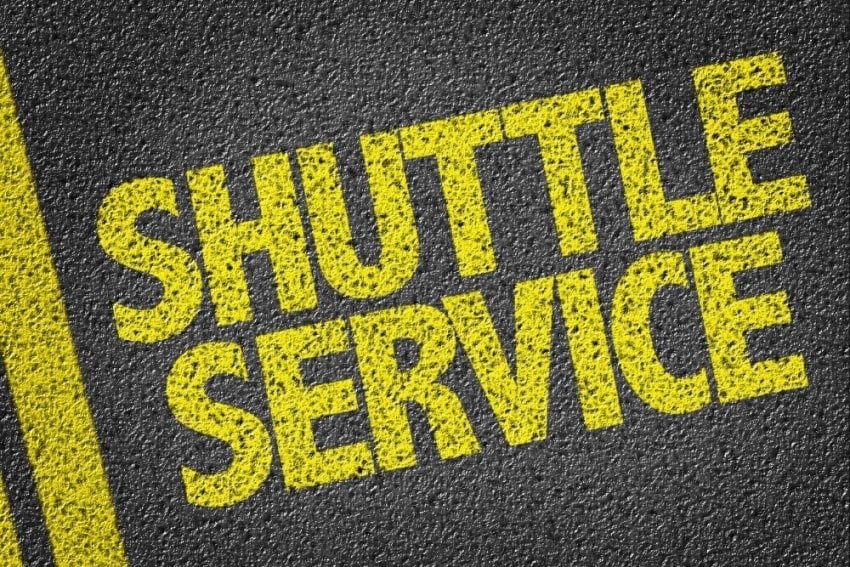
How to ride in a shuttle bus with a small baby
There are a few types of shuttle buses that parents might find themselves traveling like the Urgent Care Shuttle Busses or Shuttle busses transporting to the airport or hotels.
Each of these traveling busses does require that parents have the appropriate seat belts for their little ones.
To ride in a shuttle bus with an infant or a young child who still requires a car seat, parents should bring proper safety restraints on board.
If parents show up without proper seating for their children, they could get denied transport. Since shuttle busses are semi-small vans with seats and buckles, operating on the roads.
Most shuttle services fit in the criteria of a large van or a bus. This means they’re traveling among the highways and streets in the way a personal use vehicle operates.
Call the shuttle service ahead of time
With there being so many various types of shuttle services to choose from, it’s best to call ahead of time to figure out specifics.
You’ll likely be able to find a shuttle service that will store a car seat on board for you, for a small fee, if you intend to use their services frequently.
You can ask if it’s a one time ride if they will require you to have a car seat. Some shuttle services don’t even have working seat belts available.
However, other shuttle busses are in pristine condition, which is most likely privately owned and operated businesses.
How To Stay Safe While Boating With A Baby
Boats are a lot of fun for everyone! And we hope that babies will love boats for years to come with their families! Parents who have just had a little one might wonder how outings will change, now that they have a baby to bring on board.
What are the safety regulations, top tips, and things to look out for when boating with an infant?
Lifejackets are required for all babies on board
Babies and toddlers upward of 18lbs need to have a properly fitted lifejacket. This means that brand new infants under this size should not be brought onboard a boat.
U.S Coast Guard reinforces the rule that all people on board your boat, while it’s moving, must have a fitted lifejacket.
Have an area on your boat specifically for your baby
While all the boating action on deck is happening all at once, you might need to assist your fellow boaters at some point.
This is when a designated area, that your baby is safe and secure comes in handy. That way you can take them to that confined area anytime you need to set them down or otherwise.
Even if you plan for your only task to be caring for your baby, unexpected events(emergencies) happen, in the event of an emergency, you’d need to have your hands-free to help out in any way possible.
Plan ahead for any naps your baby will need to take
When bringing a baby on a boating trip, they’ll have more essential needs. Hydration, soothing, and sleep are all things that your baby will need a bit more of. If you’re lucky, your infant will be rocked into a deep nap by the boat itself.
View in gallery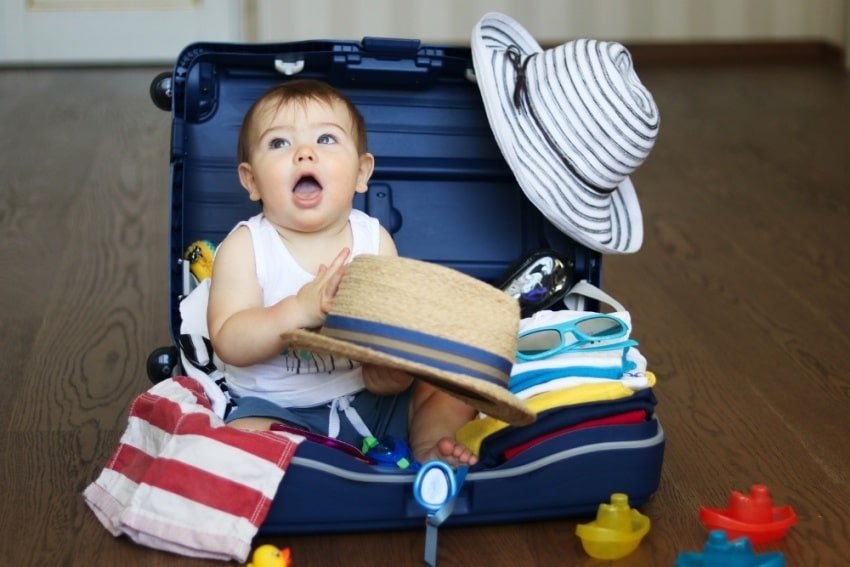
If your baby is on edge about being on board, they might require a little extra soothing, having a designated spot for napping is crucial for a successful boat trip. Pack-n-Plays or a simpler rocker is perfect for naptime.
There should be a shady spot on board
Next to having a spot for naptime, shade is one of the most important environmental needs for a small child while onboard a boat. This will make it possible to keep them hydrated while they relax out of the sunshine.
Small kids will absolutely get sunburnt if they’re in direct sunlight the entire time you’re out. Even if your trip is planned to be short, a spot out of the sun is essential.
Check the weather ahead of time
The time of day that you start your trip will make the biggest difference for small babies. If you leave in the early hours of the day, you’ll have the best trip. The weather is cooler and the tides are more mellow compared to the middle of the day.
Rush hour happens on the waterways too, it’s usually early to mid-morning that boaters will head out for the day then they stay out as late into the evening as possible.
Plan to check the weather only by taking trips on clear days, then leave as early as possible or wait until the afternoon rush is over around 1:00 pm.
There should be an overabundance of supplies
Swim diapers, snacks, juices, and water to hydrate the baby. Make sure you have plenty of these items for your baby. You want to finish your boat trip off with some leftover supplies.
Consider having an ice chest strictly for babies on board. It’ll help keep things organized and out of the hands of everyone else.
Be ready to hold your baby a lot
Your baby will be the safest in your arms. So hold your baby as much as possible and remember to have fun while out on the water!
Bring familiar toys for your little one that will make them feel more comfortable on unfamiliar grounds. It’s always best to have someone on board designated to helping you with your baby.
The Top Baby Boating Accessories Available in 2020
Full Throttle Baby-Safe Vest
Every person on board a boat needs to have proper safety gear, especially your infant. This snug little life vest is built specifically for small babies under 30lbs. It wraps in a way that is comfortable even for the smallest bodies.
It’s difficult to find a lifevest that suits very small babies, but the Full Throttle has everything you need to ensure your peace-of-mind as a parent to a super small baby.
The convenient head collar makes it easy for you to unbuckle it in case a baby is spitting up food while wearing it.
The other sturdy strap wraps around the back of the baby’s body adjustable to suit various sizes. The difference between this lifevest and one for older children is in the way the straps are designed.
The crotch strap is extra wide, scrunchy, and made with long-lasting fabric. The wide strap underneath the bum of your baby creates super-support for smaller babies.
You don’t have to worry about your baby drifting away in case of an emergency because there’s a safety grab on the oversized collar. The wrap-around headrest keeps babies’ heads out of water in the case of an accident.
Nothing is as important as the US Coast Guard Approved infant life vest for a day on the water.
Pros
- Parents of small infants are happy with the way it fits
- It has an adorable design
- The headrest is more supportive than most people expected
- Babies can wear this while inside other floating toys too
Cons
- It doesn’t offer a ‘V’ neck which is more suitable for an infant
[amalinkspro type=”cta-btn-css” ctabtn-id=”” asin=”” apilink=”https://www.amazon.com/dp/B00GNDG7HI?tag=mominformedcom-20&linkCode=osi&th=1&psc=1″ addtocart=”false” new-window=”true” nofollow=”true” alignment=”aligncenter”]Buy on Amazon[/amalinkspro]
ChittyBabes Thermal Swimsuit
The Cheekabo One Piece Thermal will keep your baby the right temperature while out on the water. Babies lose body heat a lot faster than adults will, even if you aren’t cold, your baby could feel a lot different.
A thermal one piece will keep conditions like hypothermia at bay, and your mind at ease. Before any boat with an infant, you should study the signs of hypothermia to be prepared for any unexpected emergencies.
Made with material that is gentle on sensitive skin that small babies have. It’s certain to be chemical-free as it’s undergone the chemical safety tests performed by SGS.
This one-piece swimsuit for babies not only keeps little ones warm, it cuts UV rays while doing so. This makes it easy to apply sunscreen to the exposed skin, while the body stays covered with the one piece.
It comes in a variety of vibrant colors for either gender.
Pros
- Babies will stay in the water longer with this on
- Runs a little small so babies under 6 months can likely fit in it too
- It’s very soft on the skin and doesn’t pinch anywhere
- Thick stitching that won’t come out easily
Cons
- It doesn’t have an opening to change a diaper on the bottom
[amalinkspro type=”cta-btn-css” ctabtn-id=”” asin=”” apilink=”https://www.amazon.com/dp/B07XL7WLVQ?tag=mominformedcom-20&linkCode=osi&th=1&psc=1″ addtocart=”false” new-window=”true” nofollow=”true” alignment=”aligncenter”]Buy on Amazon[/amalinkspro]
Aqua Socks for Infants
Protecting your baby’s delicate feet is a must-have during a boating trip. Since little ones are so squirmy they could snag an unforeseen sharp piece of plastic or screw – except with these polyester booties their little feet will be protected.
While keeping your little one’s feet protected from screws or nails, they will stay warm too!
Skin shoes are designed to keep your baby’s feet warm while in the water playing, which is often one of the first reasons infants need out of the water.
The biggest areas that body heat will be escaping from the body of a small infant is their head, core, and feet. Once the feet get too cold, they have a very hard time warming back up.
You don’t have to worry as much about that when your infant is wearing these aqua socks. Easy to slip on and pull off, put them on before you hit the shore so your baby can walk around with ease.
Pros
- Available in a few different sizes
- Equipped with a rubber sole for extra protection and gripping
- You have plenty of pattern choices
- Fit true to size
Cons
- The insoles aren’t connected so they slip in and out
[amalinkspro type=”cta-btn-css” ctabtn-id=”” asin=”” apilink=”https://www.amazon.com/dp/B0744DY6FW?tag=mominformedcom-20&linkCode=osi&th=1&psc=1″ addtocart=”false” new-window=”true” nofollow=”true” alignment=”aligncenter”]Buy on Amazon[/amalinkspro]
Wide Brim UPF50 Sunhat
Ami & Li not only designed an adorable sunhat for infants, but they also made sure it was sunproof too. Keep your baby protected from harmful UV rays with the UPF50+ sunhat.
Sewn with a specially designed weave that is not treated with chemicals in any way. You don’t have to worry about it breaking down after running it through the washing machine numerous times.
Most hats come with a string around the neck that can slip on or off – some are equipped with velcro – and the Ami&Li hat has a plastic clip buckle on the neck string. If you’ve had a baby before then you know how big of a difference this makes for you.
The buckle helps you keep track of your baby’s hat, you can clip it to the diaper bag so it doesn’t fly away when it’s not being worn.
It’s nice that you can choose which design fits with your little one’s swimsuit and if any problems occur with your order the company offers 24/7 customer support.
Pros
- Parents and babies like the density of the hat
- Fits babies with a very small head
- Babies can wear it for a few months since it’s adjustable
- The size of the wide bill is perfectly sized
Cons
- The color might fade out in the sun easily
[amalinkspro type=”cta-btn-css” ctabtn-id=”” asin=”” apilink=”https://www.amazon.com/dp/B07MZR5KZ1?tag=mominformedcom-20&linkCode=osi&th=1&psc=1″ addtocart=”false” new-window=”true” nofollow=”true” alignment=”aligncenter”]Buy on Amazon[/amalinkspro]
Summer Pop ‘n Sit Seat
Out on the boat, you’ll want a place for your baby to sit and eat if they already have solid foods. Aside from that having a place to sit them in a safe area to play with a few handheld toys is helpful.
The Summer Pop booster seat makes it easy for parents to pop it out while still holding their baby.
Fits babies up to 37lbs, which means they can use this booster seat from an infant to toddler years. The adjustable belt straps maneuver perfectly while your baby is growing.
Equipped with machine-washable fabric, for easy cleanup after mealtime. The 3-point harness makes it one of the safest pop-up booster seats available for traveling on boats.
After your boat trip is done, and you head out to eat pop this up in the restaurant you stop by on the way home too.
Pros
- Locks on each side of the tray
- Comes with safety straps to attach to a regular chair nicely too
- Parents call it the best $30.00 they’ve ever spent
- Toddlers can use it too
- Fits perfectly in small areas
Cons
- The tray ends up being a bit small once your baby reaches 1 year old
[amalinkspro type=”cta-btn-css” ctabtn-id=”” asin=”” apilink=”https://www.amazon.com/dp/B07PLVFGBB?tag=mominformedcom-20&linkCode=osi&th=1&psc=1″ addtocart=”false” new-window=”true” nofollow=”true” alignment=”aligncenter”]Buy on Amazon[/amalinkspro]
Conclusion
We get it, the eagerness, and the endless questions you have regarding an upcoming trip with a small baby. It can be overwhelming for parents, especially if you haven’t been on a trip at all yet with your small baby.
It takes work to wrap your mind around all of the little details that make or break a travel outing. And that’s where we come in, to help your family stay safe.
While you’re searching for all the necessary information to ensure the safest trip research means everything – learning from other parents is your greatest tool.
This article contains all the information parents feel is important for you to think about. The goal is to keep your baby safe while traveling.
Whether you’ll be taking a one-way taxi ride, a shuttle or greyhound trip, or going out for the first time on a boat with your baby of course comfort and safety top all other concerns.
When you have a newborn, you definitely have to adjust your trip to be more suitable for your baby.
The tips and tricks in this article will help you make informed decisions to ensure your infant stays safe from the start to the end of your vacation. And remember to have fun on your trip with your little one! You deserve it.
Sources
Tips For Taking a Taxi Cab With Kids
Traveling in a big city with a baby. What do you do about the car seat?
Tips for Taking Taxi Trips With Babies and Toddlers
Can a Baby Sit on Your Lap in a Taxi? Rules Around the World
